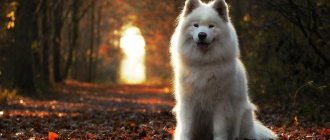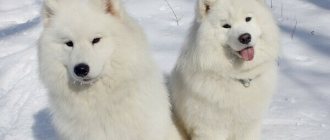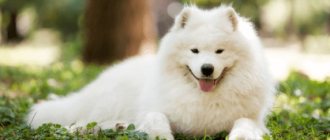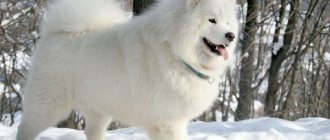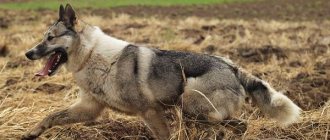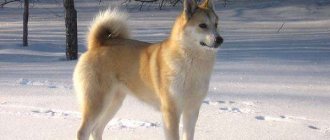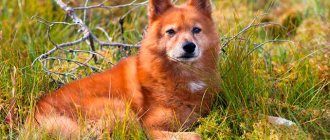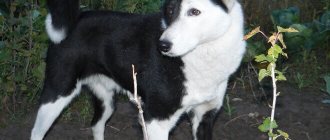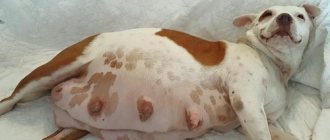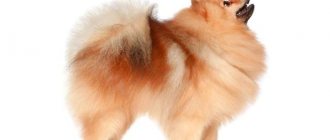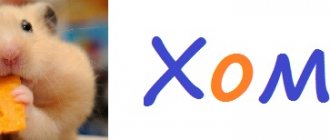The Samoyed is one of the oldest dog breeds, born in the harsh northern climate.
The name itself - “Samoyed” - indicates the relationship to the Samoyed tribes, from which this breed originated.
Samoyeds themselves are similar to polar bear cubs, and their character is characterized by playfulness and cheerfulness, combined with high intelligence.
Breed characteristics
| Short description | |
| Origin: | Russia, northern region (Siberia, circumpolar region) |
| Conditions of detention: | In an apartment or in a country house |
| Purpose: | Sled dog, partner |
| Color: | Pure white, minor fawn markings allowed |
| Wool length: | Medium, thick, double |
| Adult dog size: | Males: height from 54 cm to 60 cm; weight from 25 kg to 30 kg Females: height from 50 cm to 56 cm; weight from 17 kg to 25 kg |
| Average life expectancy: | 12-15 years |
| Walk: | 2 times a day, lasting at least 1 hour each |
| Physical activity needs: | High intensity, requires active exercise, predominantly aerobic in nature |
| Fédération Cynologique Internationale (FIC) classification: | The breed was recognized by the FCI in 1959. Group 5. Spitz and primitive breeds/section 1. Northern sled dogs |
| Puppy price: | Average cost:
|
Socialization
The Samoyed Laika is completely devoid of aggression. Moreover, aggression is considered a breed defect. This is a completely social animal. The Samoyed dog belongs to a pack, and this is how it perceives all family members. Therefore, the puppy also needs to be explained who is boss in the house.
The white husky knows how to use its charm, and the owner himself will have to learn to resist it. She's very smart. The presence of high intelligence is a distinctive characteristic of the breed.
The husky gets along with other animals without problems, and has a special love for cats. They become real friends.
The Samoyed Spitz is clean, free of hereditary defects, gets along well with children, showing great tolerance with them. Siberian huskies were originally nannies for children and have not lost these traits. They are able to tolerate any child, even if he is annoying. The dog will leave, hide, but will never touch a person. It is believed that if there are small children in the family, it is better to have a Samoyed girl. For older children (from 10 years old) a boy is suitable.
History of the origin of the species
There are many legends and guesses regarding the history of the origin of the Samoyed dog . According to one version, they accompanied the small northern Samoyed tribes, which are usually classified as a Finno-Ugric group. The ancestors of the Nenets, Enets and other peoples settled in the territories of the modern Nenets and Yamalo-Nenets Autonomous Okrugs, as well as partially in the Tyumen region and Taimyr in the 11th century BC.
The primitive peoples inhabiting the Far North in that era were hunters and gatherers . Given the harsh climatic conditions, the need naturally arose to involve a dog in the main types of human activities. There is an assumption that a wolf adapted to the Arctic cold was used for these purposes. However, there is no rigorous scientific evidence to support this point of view.
The hypothesis of the domestication of the wolf can only be supported by the thick white fur and characteristic elongated muzzle of the modern Samoyed. The geographical limitations of the region led to the fact that by the beginning of the 19th century AD. The dog's genotype was considered completely lost. Thus, it is generally accepted that modern individuals have nothing in common with their ancestors.
What is known for certain is that in 1889, the English naturalist Ernst Kilbrun Scott, after living for several months among the Samoyed tribe, brought a dog puppy to his homeland. Later, two more puppies were brought from the Western Urals - a male and a female. It was these individuals that served as the basis for selection, and the breed quickly spread to the western part of the European continent. Samoyeds returned to Russia relatively recently.
Now the number of animals, according to various estimates, ranges from 1800 to 2500 specimens.
Application
Its gentle character and beauty make the Samoyed more and more popular. He is brought in primarily as a companion.
The meaning of life for a Samoyed Laika is to be close to a person and serve him.
In America, Sammy has the title of “Good Mood Dog.”
Laika Samoyeds were primarily herding dogs and only then sled dogs. They are also excellent herd guards and bodyguards.
Arctic Spitz are also used as hunting dogs. The peoples of the north rarely harness them to sledges. For them, the husky is primarily a shepherd who leads a herd of deer.
Sammi are good guards. But they do not attack a stranger, do not bite, but warn the owner about an uninvited visit by barking. Therefore, Samoyed huskies are multifunctional, and it is wrong to attribute only the prefix “sled” to them.
The Samoyed dog breed is distinguished by intelligence, intelligence, and excellent learning abilities. She is easily given a general training course, bidience, agility, and other types. It’s just important not to bore the dog with the same type of exercises and tasks.
Now they buy dogs for skiing (skijoring), sledding, and sledding. But breeders still do not recommend breeding a Sammy for sport. They are hardy, strong, but not fast. Although the Samoyed has courage and if you put on a harness, he will happily pull the sled. He doesn’t even need to be taught this.
Distinctive features
Samoyeds are well-recognized dogs . According to the unofficial classification, which dates back to the beginning of the 20th century, they are conventionally divided into three subspecies. Thanks to E.K. Scott's descriptions include the following types:
- Bear-shaped;
- Fox-shaped;
- Wolf-like types.
The main difference is the shape of the head, corresponding to the name. All other exterior characteristics have the same attributes:
- The head is very powerful.
- The skull is wide (bear-shaped type) or wedge-shaped (fox-shaped and wolf-shaped types).
- The frontal part is wide, slightly convex when viewed from the front.
- The ears are small; wide, high stance; the ends are slightly rounded; the inner surface is completely covered with thick hair.
- The muzzle is deep, the narrowing towards the nose is slight.
- The nose is wedge-shaped.
- The nose is black or dark brown; in winter it can completely lose color; there must be a black border.
- The eyes are dark brown, deep set, wide set, almond shaped.
- bite .
- The teeth are strong, a complete set of 42 pieces.
- The jaws are powerful.
- The lips fit tightly, forming a recognizable “smile.”
- The neck is strong and relatively short.
- The body is stocky.
- The limbs are straight, parallel, strong muscles are clearly expressed.
- The coat is medium length, straight, very dense, shiny, double coat; there is a short, dense undercoat; noticeably fuller around the neck, shorter on the limbs; characteristic “breeches” on the hips; there is protective hair between the fingers; “ruffles” during frosty, snowy periods; has self-cleaning properties.
- The tail is fluffy and saber-shaped when moving.
- The color is pure white, minor fawn markings are allowed; the setting is high.
Samoyed Laika: description
Nowadays, the Spitz breed is considered to be the oldest of all breeds known today, and is a breed that has completely escaped the intervention of various breeders. In this regard, it is believed that the majority of Samoyeds are due only to natural factors associated with the character traits of this animal.
Despite the fact that the Spitz breed is considered exceptional these days, since it was lucky enough to avoid the interference of breeders, which in one way or another could have influenced the exterior and behavior, all its qualities are associated with the natural characteristics of the breed.
Appearance
This dog breed, distinguished by its white color and medium size, is characterized as a breed that has an original appearance, while one can notice a certain power and endurance, which are combined with natural charm and a peculiar softness. Samoyed Laikas, by their behavior, indicate their dignity and self-confidence, due to which they often attract special attention.
The “Samoyed smile” is a factor that is a distinctive feature of the breed. Despite this, all features are associated with a special expression of the muzzle, which is associated with the special location and shape of the eyes. In addition, this is facilitated by a slight upward bend of the corners of the mouth.
Interesting moment! Bear-type Samoyeds are characterized by a fairly short back, a slender build and a large, wide head. As for the wolf type, individuals are distinguished by an athletic build, medium-sized breasts, a moderately elongated muzzle, and wedge-shaped.
Kilnburn Scott, who breeds these dogs, prefers three main types of Samoyeds: bear-shaped, fox-shaped and wolf-shaped. Therefore, a similar classification of Samoyeds is still valid in various circles of dog breeders.
Coat type and color
The coat of this breed is quite long and dense with a pronounced undercoat. Therefore, in connection with the requirements of breed standards, Samoyed wool should be thick, dense, but pliable (soft).
The “polar” coat of Samoyeds consists of 2 categories of coat:
- Made of short, but very soft and dense undercoat.
- Made from longer, straighter and coarser guard hairs.
The area of the neck and shoulder girdle is characterized by the presence of a kind of “collar”, which is more pronounced in males. On the head and front parts of the limbs the hair is not so long, but even. The outer side of the ears is covered with short, vertical hair. On the inner surface of the ears you can notice abundant pubescence. The back of the thigh is covered with lush and long hair, which forms the so-called “pants”. A protective coat of wool is also located between the dog’s toes, and the tail is distinguished by the presence of a fairly thick coat of wool.
Interesting to know! In females, according to accepted breed standards, the coat is not so long and not so hard, and, regardless of gender, it must have a certain structure, and also have a peculiar sparkling shine.
The color of purebred individuals should be white, cream or white, with the presence of a biscuit tint. The appearance of the coat should not create any illusions of the presence of grayish, brownish-yellow or pale brown tones in the main color.
Samoyed dog - All about the dog breed | Dog breed - Samoyed dog
Breed standards
By its nature, the Samoyed Laika is considered not an aggressive, but also a non-fearful animal, which must meet the following breed characteristics:
- The head is powerful, wedge-shaped with a wide skull between the ears, which has a slight convexity. The stop is not too sharp, and the furrow between the eyes is barely noticeable.
- The nose is usually black and well developed, with a pronounced dark edging.
- The muzzle is strong and very deep, and its length corresponds to the length of the skull. At the same time, it slowly narrows and turns into a straight back.
- The lips fit tightly and are black in color, while they appear to be plump, with barely noticeable bends at the corners.
- The teeth are strong and strong, with an almost perfect scissor bite.
- The eyes are almond-shaped, slightly slanted, deep-set and wide, dark brown in color.
- The ears are erect and small, although they are thick and triangular, at the same time, they have a slight rounding at the end and are very mobile.
- The neck is of medium length, but it is strong and well developed, and proudly arched.
- The body is quite compact and strong, at the same time it is quite flexible, and the withers area is well defined.
- The back is characterized as medium in length and strong. At the same time, she is straight, with a muscular lower back, as well as a powerful and slightly sloping croup.
- The chest is wide and deep, reaching to the elbow area, and the ribs are quite elastic.
- The tail is set high and thrown behind the back and slightly to the side. When the dog is at rest, it is always lowered.
- The forelimbs are strong and muscular, well set. The shoulder blades are long, strong, and inclined. The shoulders are also sloping and close to the body. The wrists are strong and quite flexible.
- The paws are oval in shape, with long toes that fit loosely together.
- The hindquarters are muscular and strong, with powerful thighs. The hock joints are located relatively low. The hocks are short and powerful.
The dog moves powerfully, but quite freely. The step is long, which is associated with the rather long reach of the animal’s front legs, as well as powerful pushes of the hind legs. The maximum height at the withers for a male dog is no more than 60 cm, and for a female dog - no more than 56 cm, with a maximum weight of 30 kg for a male dog and 25 kg for a female dog.
Dog character
The Samoyed Laika is distinguished not only by its attractive appearance, but also by its very friendly character. Dogs of any age are gentle and attentive to children, and have a positive mood, regardless of their habitat. They easily find a common language with the human environment, as well as with other pets.
Although this breed is not very active, it requires serious physical activity in the form of constant motor training. The dog is characterized as sociable, while it has protective instincts, as well as a high desire to work physically.
Due to the high degree of sociability, Samoyeds have a hard time withstanding long-term separations associated with lack of communication. Therefore, this breed is not suitable for keeping for people who are often away, at work, or simply outside their home.
Lifespan
As far as is known, dogs of this breed can live on average about 14 years, although representatives of this breed, representing Italian or English breeders, live no more than 10 years. These dogs retain their friendliness and playfulness until the last days of their lives.
SAMOYED LIKE ALL ABOUT THE BREED. INTERESTING FACTS
Photo of an adult dog
Health
Sammi are distinguished by good health. Samoyeds live a long time (up to 15 years) and rarely get sick. There are cases of longevity - up to 18 years.
Diseases
Samoyed huskies do not have genetic diseases. The most common health problems are:
- hip dysplasia;
- cataract, glaucoma, retinal atrophy;
- bloating;
- deafness.
The main problem in spring and autumn is ticks. Treatment and daily inspection are required. Collars (they are changed every month), spray, for example, from Bars, or tablets are suitable.
Only dogs that are infected with helminths have fleas. Therefore, pets are wormed regularly.
Puppies up to six months are wormed monthly. Adult huskies every 3-4 months. The following anthelmintic drugs are used: Dironet, Cestal, Drontal.
Vaccinations
Samoyeds must be vaccinated against diseases on time. Before vaccination, the pet is given an anthelmintic 1-1.5 weeks before vaccination. The most commonly used drugs are: Dosalid, Cestal, Milbemax.
Vaccination schedule:
| Vaccination sequence | Age | Name of diseases |
| First vaccination | 40-45 days | plague and parvovirus enteritis |
| Second | 2 months | plague, parvovirus enteritis, hepatitis, leptospirosis of 2 serotypes and parainfluenza |
| Third | 3 months | The same as at 2 months of age, plus a rabies vaccine is added |
The Nobivak, Duramun, and Eurikan vaccines have proven themselves to be the best. Each vaccine has its own application regimen. Your veterinarian will tell you which one is best to choose.
Until 3 months, until all vaccinations have been completed, Samoyed puppies are not allowed to go for walks.
Photos of puppies
Features of character and behavior
Despite the harsh, cold climate in which the breed was formed, modern Samoyeds, otherwise called Samoyed Laikas, bear little resemblance to their ancestors. They are extremely trusting, friendly and playful.
The best activity is considered to be a fun game in a large group of people, including small children. Based on these characteristics, you should not expect the Samoyed to display watchdog or security qualities.
The barking with which they unlimitedly accompany their running around serves rather to attract attention. They love to rush around, fuss, and are able to run far. Therefore, owners need to keep their pets in sight while walking. Hunting qualities have been lost. Movements are free, with a noticeable push of the limbs.
Advantages
Samoyeds have considerable advantages:
- Great companions;
- They have a good-natured, cheerful, playful character;
- Energetic, active, love movement;
- Smart and easy to train;
- Unpretentious, suitable for keeping in an apartment;
- They do not have a dog smell;
- Wool has the property of self-cleaning;
- Absolute absence of aggressive behavior;
- Great for inexperienced owners;
- High life expectancy;
- They get along well with small children and pets.
Flaws
The Samoyed dog has practically no disadvantages. The main problems associated with the breed include the following:
- Increased attention must be paid to coat care.
- The need for high intensity and duration of exercise.
- Expressed contact, including with strangers. This may cause the loss of the dog. Owners must be extremely careful when walking.
- On the street they can run after yard cats. To avoid this behavior, your pet should be trained from puppyhood.
- Heavy shedding.
Nutrition
Despite the active lifestyle characteristic of the northern breed, Samoyeds are not gluttonous; they eat relatively little. You can feed them dry food or natural products. In the first case, it is recommended to purchase premium food from reliable, trusted sellers. In the second case, dog food should not be expired. The food is bought high quality, fresh. Only with a properly formulated diet will a puppy grow into a beautiful, healthy, active dog.
Nutrition should be balanced. It is necessary to provide your pet with vitamin and mineral supplements. It is forbidden to feed food from the owner's table, as spices and salt are harmful to the animal's body. It is also prohibited to feed the dog smoked meats, sweets, small chicken and pork bones, and fatty dairy products.
Samoyeds' favorite delicacy is fish. It is recommended to add sea fish to your food or give it as a treat. Cottage cheese and seaweed are also useful; these products are recommended to be fed in the morning.
With a natural feeding method, the basis of the diet is meat. At the same time, pork is prohibited; the ideal option is beef.
Care and maintenance
Representatives of this breed are very unpretentious, able to adapt well to both heat and cold. This is their absolute advantage over other dogs. They are well suited for keeping in an apartment, but can also live in an enclosure.
Due to high activity and sociability, the preferred location is next to the owner.
Bathing a Samoyed is a simple procedure that only needs to be done once a year. For washing, special shampoos are usually used, without additives. If your pet resists, you can use dry cleaning products.
The presence of protective fur between the toes requires thorough washing of the paws every day, even after a walk in the dry, hot season.
The condition of the teeth is monitored once a week. The best way to prevent the appearance of tartar is to accustom your puppy to the procedure of brushing its teeth . Given the restless nature of the pet, the process may present some difficulties. It is very important not to follow the lead of the snow-white, fluffy miracle and persistently remove plaque. To do this, you can use special brushes that are placed on your finger, or dental sponges for dogs. Additionally, it is recommended to examine your gums.
Signals for a mandatory visit to the veterinarian may be identified swelling, redness and bleeding, yellow plaque on the teeth, as well as a “rotten” odor from the mouth.
Samoyed ears are perfectly protected by fur from dust and dirt and require virtually no special care. The external structure of the hearing organs allows for only infrequent examinations, once a month. The exception is when ticks are active, when you need to check your pet’s ears daily, after every walk.
The deep seating of the eyes serves as a natural barrier and protection from both the penetration of random specks and various damages. Owners only have to examine their pet once a week and make sure that there is no excessive discharge in the corners of the eyes. Claws grow slowly and usually wear down on their own.
Nutrition
It is best to organize Samoyed nutrition on a natural basis. The diet is identical for both puppies and adult dogs and includes:
- Beef, turkey, chicken, including meat on the bone (except tubular), cartilage; boiled mosli must be excluded; the choice should be made in favor of beef with streaks, you can use soup sets;
- Meat by-products (heart, liver, kidneys); recommended 1-2 times a month;
- Scar;
- Raw eggs;
- Cottage cheese with a fat content of no more than 5%, kefir;
- Fish (sea);
- Cabbage, pumpkin, carrots raw, with the addition of 1 teaspoon of sunflower oil;
- Apples.
The use of cereals in the Samoyed menu is undesirable.
During the dog's growth period, it is necessary to follow the recommended number of feedings:
- from 3 to 5 months: 4-5 feedings per day;
- from 5 to 7 months: 3 knocking feedings;
- from 7 to 12 months: 2 feedings at knocking times.
The volume of food is 200 g. fermented milk products (morning) and 200-500 gr. meat (evening).
- Vitamin complexes are a must when eating a natural diet and you should not skimp on them. It is better to purchase expensive, high-quality supplements from well-known manufacturers (Canina, Polidex).
- Starting from 18 months, it is permissible to feed the dog once a day, before bedtime..
- Feeding immediately before walking is not allowed!
Dry food can also be used for feeding. In this case, it is advisable to choose brands that have proven themselves to produce quality products: Eukanuba, Acana, Bosch, NUTRA Gold Holistic.
We recommend that you read a detailed article on the topic: “How and what to feed a dog: types and characteristics of nutrition.”
Health
The Samoyed dog is considered to be in good health. They are hardy and have a strong immune system. Proper nutrition and adequate exercise during the puppy's growing period up to 12 months are usually sufficient conditions for good health throughout the dog's life.
Vaccinations
Despite their excellent health, vaccination of Samoyeds is mandatory.
- The first vaccination against coronavirus, distemper, viral hepatitis and enteritis is carried out at 1 month .
- Repeated vaccines are given at 2 and 3 months .
- Subsequent revaccination is carried out at 6 and 12 months , and then annually.
- The rabies vaccine can be given starting from 3 months , in the absence of contraindications related to the individual characteristics of the dog.
- At 12 months, the dog is vaccinated with a complex vaccine and repeated annually.
Important article on the topic: “Everything you need to know about dog vaccinations.”
Diseases
Diseases characteristic of this breed are few and come down to the following:
- Hip dysplasia;
- Eye diseases – glaucoma, cataracts, retinal atrophy;
- Malnutrition diseases - diabetes, bloating.
Some owners report genitourinary tract infections. In general, the breed is considered resistant to various ailments.
Walk
Samoyed huskies require quite intensive walking. Physical activity should be predominantly aerobic - running, jumping, active games. Collective “dog workouts” are encouraged.
Considering the non-conflict nature of Samoyeds, many owners have the opportunity to calmly treat their pet’s communication with other dogs. The exception is during periods of estrus, when many dogs become disobedient to one degree or another.
Grooming
The basic requirements for caring for a dog come down to taking care of the pet's coat. This involves brushing daily with a stiff bristled brush. The breed is unique in that it does not have a characteristic dog smell, which cannot but attract a large number of admirers. During the year, it is enough to brush your dog weekly.
The exception is two periods of intense molting, when a complete change of coat and undercoat occurs. During these intervals, the dog needs to be brushed on every walk, 2 times a day.
Thick hair dictates the characteristics of combing. To properly and completely remove dead hair from a dog’s croup, you need to grab a tuft of hair and comb it in the direction of growth.
For care, it is most convenient to use a slicker brush - a special comb with long metal teeth . For the back of the thigh and collar area, you can use a powder brush with short teeth; they are more effective for these parts of the body. After removing the bulk of the fluff and clumps of matted fur, you can use a comb to add shine to the coat.
Combing should start from the head, gradually moving along the body to the tail. The paws and belly also need to be carefully cleared of the fur.
The use of scissors or razors is not recommended. It is allowed to slightly trim the hair between the toes.
How to choose?
Familiarize yourself with the characteristics of the breed in advance and, if possible, talk to real breeders. Measure your strengths - can you recreate favorable conditions for her upbringing and living?
If you answered yes to each of these questions, go to the nursery.
IMPORTANT!
A puppy should be adopted at the age of 6 months. It is then that all the features of the exterior appear.
Next, the most difficult stage awaits you - choosing a puppy.
Therefore, forcefully put aside tenderness and desires to take the first baby who ran up to your call and focus your attention on the following signs of health:
- Coat : It should be thick, shiny, clean and free of clumps. The hairs should not fall off when touched.
- Stool : take the time to wait until the puppies go to the toilet and pay attention to the shape of the stool - it should not be liquid. Also pay attention to the cleanliness of the fur around the anus.
- Eyes : normally they are clean, clear, without mucus in the tear ducts.
- Ears : clean, without odor and without redness, scratches or discharge.
- Activity : the puppy must be active and cheerful, slight “childish” clumsiness is acceptable.
To prevent moving to a new place from being too stressful for your puppy, prepare your home in advance: buy bedding with thick fabric to minimize the likelihood of fleas breeding, get dishes and toys.
Also be sure to control your behavior, namely:
- Lift the puppy correctly, with both hands: place one under the chest, the other under the hips. You should not lift him by the scruff of the neck, much less pull him by the paws and tail. Also place it on the floor very carefully.
- Control your actions - do not play tug of war with the puppy - this can ruin the bite. Also, do not rub the puppy between the ears - this can ruin their shape.
- Check your puppy's health regularly and treat it for internal and external parasites.
- Do not bathe your puppy: this can disrupt the structure of his coat and cause a cold.
Mating
Bitches are mated no earlier than 18 months. If we are talking about breeding, in addition to the standard requirements for the health of the dog, an opinion on the condition of the hip joints is usually required. Considering the low prevalence of the breed, puppies born are subject to registration in one of the clubs or nurseries registered with the RKF.
Mating is possible from 11 to 14 days after the start of bleeding. It is advisable to select a male dog in advance due to the small number of individuals that are suitable for breeding.
Mating is carried out on the territory of the dog. For this purpose, it is better to involve an instructor, even if the owners have experience in carrying out this procedure. Samoyeds are very active, and the playful courtship process can last more than 10-15 minutes. Thus, the moment for mating will be missed.
Read a detailed article on the topic: “Everything you need to know about breeding dogs: appropriate age, what to do if it doesn’t work out, rules and tips.”
What varieties are there?
There are only two types of rock, which differ slightly in their structure:
- Bearish: short and powerful, stocky body, and wide skull. So named because of its resemblance to a teddy bear.
- Wolf: elongated, lean body, narrow skull. They look more graceful and fragile than their bear-type counterparts.
Key points in training
The trainability of Samoyed dogs is at a high level. However, their agile, sanguine nature requires the owner to have exceptional patience when training. Bearing in mind their pronounced ability for active physical activity with a high degree of intensity, it is advisable to take an obedience course at a fairly early age.
It is better to start exercises from 3 months. You should not count on quiet, calm processing of the commands “sit” or “lie down”. The charge of energy that dogs have does not allow them to quickly calm down and concentrate on passive tasks. It is recommended to start the training with running and practicing the “come to me” command. This will create the basis for long-term “cooperation” and mutual understanding.
Read about how to properly train a dog in the article: “Training a puppy: effective methods from dog handlers, learning commands at home.”
An additional challenge may be the high intelligence of Samoyeds. This problem can be easily solved if during training there is a frequent, unexpected change in activity for the dog - from passive walking to accelerated running. After alternating loads, dogs are more willing to comply with training requirements. In moments of disobedience, the owner must calmly, but persistently and consistently give orders until they are completely and correctly executed.
Rude shouts and the use of physical force will not lead to the desired result and will only increase the degree of mistrust.
As a punishment, it is acceptable to shake the dog slightly. Usually this measure is enough to pacify the “runaway” pet.
In addition, the Samoyed dog can be trained to search and guard premises. This area of training is not primary.
Interesting Facts
Friendliness, agreeableness and love for children, inherent at the genetic level, make these dogs indispensable for canistherapy. Thanks to communication with dogs, sick and disabled children begin to recover and recover faster. Parents and doctors often compare this process to a miracle.
Due to their highly developed intelligence and increased sensitivity, Samoyeds are kept in some psychiatric hospitals as four-legged doctors. They are sensitive to the human condition. Capable of getting people out of depression.
In addition, Samoyeds are able to detect the deterioration of a person’s physical condition by the first symptoms: a sharp rise in blood sugar, a hypertensive crisis, an epileptic attack.
